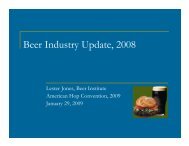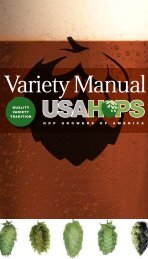Field Guide for Integrated Pest Management in Hops
Field Guide for Integrated Pest Management in Hops
Field Guide for Integrated Pest Management in Hops
Create successful ePaper yourself
Turn your PDF publications into a flip-book with our unique Google optimized e-Paper software.
Monitor<strong>in</strong>g <strong>for</strong> <strong>Pest</strong>s, Damage, and Treatment SuccessThe concepts of acceptable pest levels, economic<strong>in</strong>jury levels, and economic thresholds implya need to monitor <strong>for</strong> levels of pests or pest damage<strong>in</strong> relation to these levels. Monitor<strong>in</strong>g is fundamentalto IPM because it is used to objectivelydeterm<strong>in</strong>e the need <strong>for</strong> control and also to assessthe effectiveness of control after action has beentaken. Sampl<strong>in</strong>g and monitor<strong>in</strong>g requires the abilityto identify pests, pest damage, and key naturalenemies of pests, as well as knowledge of pest andnatural enemy biology and life history. In monitor<strong>in</strong>g,the grower or a scout takes representative samplesto assess the growth status and general healthof the crop, the presence and <strong>in</strong>tensity of currentpest <strong>in</strong>festations or <strong>in</strong>fections, and the potential <strong>for</strong>development of future pest problems. Monitor<strong>in</strong>gmay take many <strong>for</strong>ms such as presence/absence orcounts of pests from visual <strong>in</strong>spection of plants orplant parts or traps placed <strong>in</strong> or around fields (e.g.,sticky traps, pheromone traps, spore traps). Sampl<strong>in</strong>gshould be conducted to provide a representativeassessment of the pest population <strong>in</strong> all areas tobe similarly treated, such as part of a field, a s<strong>in</strong>glefield, or adjacent fields. Various sampl<strong>in</strong>g schemeshave been developed to assist <strong>in</strong> monitor<strong>in</strong>g ef<strong>for</strong>ts.Monitor<strong>in</strong>g an area <strong>for</strong> environmentalconditions (especially temperature and relativehumidity) that are favorable or unfavorable <strong>for</strong> pestdevelopment is also important. This <strong>in</strong>cludes theuse of models (e.g., the powdery mildew risk <strong>in</strong>dex,degree-day <strong>for</strong> downy mildew spike emergenceand spider mites) to <strong>for</strong>ecast conditions conduciveto disease or pest development, and survey<strong>in</strong>g thearea <strong>for</strong> the presence of alternate hosts of hop pests(e.g., agricultural or ornamental varieties of prunethat might harbor overw<strong>in</strong>ter<strong>in</strong>g hop aphids) andnatural enemies (e.g., flower<strong>in</strong>g weeds that providehabitat <strong>for</strong> natural enemies).Monitor<strong>in</strong>g, when conducted rout<strong>in</strong>ely—at least weekly dur<strong>in</strong>g the grow<strong>in</strong>g season—and<strong>in</strong> comb<strong>in</strong>ation with good record keep<strong>in</strong>g andawareness of model <strong>for</strong>ecasts, can help determ<strong>in</strong>etrends <strong>in</strong> pest and natural enemy populationgrowth over time. This assists <strong>in</strong> plann<strong>in</strong>g <strong>for</strong>pest management decisions and assess<strong>in</strong>g theeffectiveness of control actions.Check theAgWeatherNetwebsite at URLhttp://weather.wsu.edu/ <strong>for</strong>available diseaseand pest models.Consult withlocal experts <strong>for</strong><strong>in</strong><strong>for</strong>mation on usesand limitationsof pest <strong>for</strong>ecastmodels <strong>in</strong> IPM.3Multi-tactic <strong>Management</strong> ApproachesWhen prevention is not effective or possibleand monitor<strong>in</strong>g <strong>in</strong>dicates that a pest population hasreached or exceeded an action threshold, <strong>in</strong>terventionis required to lower pest numbers to acceptablelevels. For any given pest situation, pest/crop managerswill need to choose one or more appropriateand compatible management tactics. The basictypes of controls are mechanical, biological, andchemical.Mechanical controls <strong>in</strong>clude simple handpick<strong>in</strong>g,erect<strong>in</strong>g barriers, us<strong>in</strong>g traps, vacuum<strong>in</strong>g,and tillage to disrupt pest growth and reproduction.Tillage is commonly used to manage weeds <strong>in</strong>hop, and can be important <strong>in</strong> manag<strong>in</strong>g arthropodpests such as the garden symphylan.Biological controls are beneficial organismsthat prey on or parasitize pests, or organisms thatdo not damage crops but compete with pests <strong>for</strong>habitat and displace pests (e.g., Bacillus pumilus <strong>for</strong>powdery mildew management). Some biologicalcontrol agents are commercially available <strong>for</strong> release<strong>in</strong>to cropp<strong>in</strong>g systems (i.e., fields, greenhouses) <strong>in</strong>numbers that can overwhelm pests or that supplementexist<strong>in</strong>g natural enemy populations. Add<strong>in</strong>gagents to the ecosystem is referred to as augmentativebiocontrol; an example would be the releaseof predatory mites Galendromus occidentalis and/orNeoseiulus fallacis, which can be purchased and released<strong>for</strong> management of twospotted spider mites.Natural enemy populations also can be augmentedus<strong>in</strong>g commercially available chemical attractants,such as methyl salicylate. Biological control also canbe implemented by manag<strong>in</strong>g crops to conserveexist<strong>in</strong>g natural enemies (conservation biologicalcontrol) through preserv<strong>in</strong>g habitat (<strong>in</strong>clud<strong>in</strong>galternative hosts and prey) necessary <strong>for</strong> normalnatural enemy growth and reproduction, or by us<strong>in</strong>gmanagement tactics (e.g., selective pesticides orpesticide uses) that have m<strong>in</strong>imal negative impacton natural enemies. In hop, biological control ismost widely practiced <strong>in</strong> the <strong>for</strong>m of conservationbiological control through the use of selective pesticidesand modified cultural practices.Chemical controls <strong>in</strong>clude synthetic andnatural pesticides used to reduce pest populations.Many newer synthetic pesticides are much lessdisruptive to non-target organisms than older,broad-spectrum chemistries (e.g., organophosphate,carbamate, and pyrethroid <strong>in</strong>secticides). Insecticidesderived from naturally occurr<strong>in</strong>g microorganismssuch as Bacillus thur<strong>in</strong>giensis, entomopathogenicfungi and entomopathogenic nematodes, andnatural <strong>in</strong>secticides such as nicot<strong>in</strong>e, pyrethr<strong>in</strong>,and spynos<strong>in</strong>s are important tools <strong>in</strong> many organicfarm<strong>in</strong>g operations, and are play<strong>in</strong>g larger roles <strong>in</strong>non-organic crop production. Selective pesticidesshould be chosen over non-selective pesticidesto preserve natural enemies and allow biologicalcontrol to play a greater role <strong>in</strong> suppress<strong>in</strong>g pestoutbreaks. However, broad-spectrum pesticidesrema<strong>in</strong> useful and necessary components of IPMprograms as measures of last resort when othermanagement tactics fail to ma<strong>in</strong>ta<strong>in</strong> pests atacceptable levels.Photos Above: A. J. Dreves,D. H. Gent, D. H. Gent








